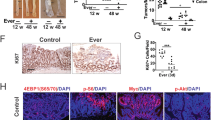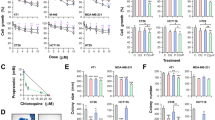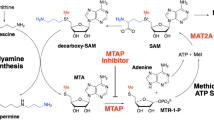Abstract
A combination of two drugs afforded remarkable protection from intestinal neoplasia in APCMin/+ mice, a murine model of human familial adenomatous polyposis (FAP). One of the drugs was sulindac, a prototypical non-steroidal anti-inflammatory drug with established chemopreventative activity. The second drug was EKI-569, a newly developed, irreversible inhibitor of the epidermal growth factor receptor kinase. Although 100% of the untreated APCMin/+ mice developed ∼20 polyps, nearly half the mice treated with these two agents developed no polyps at all. These results suggest a powerful strategy for the chemoprevention of human colonic neoplasia.
This is a preview of subscription content, access via your institution
Access options
Subscribe to this journal
Receive 12 print issues and online access
$209.00 per year
only $17.42 per issue
Buy this article
- Purchase on Springer Link
- Instant access to full article PDF
Prices may be subject to local taxes which are calculated during checkout



Similar content being viewed by others
References
Slack, J.L. The biology and treatment of acute progranulocytic leukemia. Curr.Opin.Oncol. 11, 9–13 (1999).
Johnson, S.C. & Gerber, J.G. Advances in HIV/AIDS therapy. Adv.Intern.Med. 45, 1–40 (2000).
Badtian, I. & Colebunders, R. Treatment and prevention of multidrug-resistant tuberculosis. Drugs 58, 633–661 (1999).
Hong, W.K. & Sporn, M.B. Recent advances in chemoprevention of cancer. Science 278, 1073–1077 (1997).
Hawk, E., Lubet, R. & Limburg, P. Chemoprevention in hereditary colorectal cancer syndromes. Cancer 86, 2551–2563 (1999).
Giardiello, F.M. NSAID-induced polyp regression in familial adenomatous polyposis patients. Gastroenterol.Clin.North Am. 25, 349–362 (1996).
Gran, V.R. et al. Prevention with tamoxifen or other hormones versus prophylactic surgery in BRCA1/2-positive women: a decision analysis. Cancer.J.Sci.Am. 6, 13–20 (2000).
Osborne, M.P. Chemoprevention of breast cancer. Surg.Clin.North.Am. 79, 1207–1221 (1999).
Papadimitrakopoulou, V.A. et al. Biochemoprevention for dysplastic lesions of the upper aerodigestive tract. Arch. Otolaryngol. Head Neck Surg. 125,1083–1089 (1999).
Toma, S., Raffo, P., Isnardi, L. & Palumbo, R. Retinoids in lung cancer chemoprevention and treatment. Ann.Oncol. 10, S95–102 (1999).
Brenner, D.E. Multiagent chemopreventative agent combinations. J.Cell.Biochem.Suppl. 34, 121–124 (2000).
Kinzler, K.W. & Vogelstein, B. Lessons from hereditary colorectal cancer. Cell 87, 159–170 (1996).
Dubois, R.N. & Smalley, W.E. Cycloxygenases, NSAIDs and colorectal cancer. J.Gastroenterol. 6, 898–906 (1996).
Boolbol, S.K. et al. Cyclooxygenase-2 overexpression and tumour formation are blocked by sulindac in a murine model of familial adenomatous polyposis. Cancer Res. 56, 2556–2560 (1996).
Beazer-Barclay, Y. et al. Sulindac suppresses tumourigenesis in the Min mouse. Carcinogenesis 17, 1757–1760 (1996).
Su, L.K. et al. Multiple intestinal neoplasia caused by mutation in the murine homolog of the APC gene. Science 256, 668–670 (1992).
Wolfe, M.M., Lichtenstein, D.R. & Singh, G. Gastrointestinal toxicity of non-steroidal anti-inflamatory drugs. NEJM. 340, 1888–1899 (1999).
Bjorkman, D.J. Current status of nonsteroidal anti-inflammatory drug (NSAID) use in the United States: risk factors and frequency of complications. Am.J.Med. 105, 8S–10S (1998).
Kirschbaum, M.H. & Yarden, Y. The ErbB/HER family of receptor tyrosine kinases: A potential target for chemoprevention of epithelial neoplasms. J.Cell.Biochem. Suppl. 34, 52–60 (2000).
Kapitanovic, S. et al. The expression of p185(HER-2/neu) correlates with the stage of disease and survival in colorectal cancer. Gastroenterology 112,1103–1113 (1997).
De Angelis, E. et al. Expression of cripto and amphiregulin in colon mucosa from high risk colon cancer families. Int.J.Oncol. 14,437–440 (1999).
Maurer, C.A. et al. Increased expression of erbB3 in colorectal cancer is associated with concomitant increase in the level of erbB2. Hum.Pathol. 29, 771–777 (1998).
Ozgul, C., Karaoz, E., Erdogan, D. & Dursun, A. Expression of epidermal growth factor receptor in normal colonic mucosa and in adenocarcinomas of the colon. Acta.Physiol. Hung. 85,121–128 (1997)
Shirai, H. et al. Expression of growth factors and their receptors in human early colorectal carcinomas: immunohistochemical study. Anticancer.Res. 15,2889–2894 (1995).
Saeki, T. et al. Differential immunohistochemical detection of amphiregulin and cripto in human normal colonand colorectal tumours. Cancer Res. 52, 3467–3473 (1992).
Haeri, R., Pippin, J. & Drebin, J.A. Down-regulation of HER2/neu expression induces apoptosis in human cancer cells that overexpress Her2/neu. Cancer Res. 60, 560–565 (2000).
Discafani, C.M. et al. Irreversible inhibition of epidermal growth factor receptor tyrosine kinase with in vivo activity by N-[4-[(3-bromophenyl)amino]-6-quinazolinyl]-2-butynamide (CL-387,785). Biochem.Pharmacol. 57, 917–925 (1999).
Karnes, W.E. Jr. et al. Inhibition of epidermal growth factor receptor kinase induces protease-dependent apoptosis in human colon cancer cells. Gastroenterology 114, 930–939 (1998).
Woodburn, J.R. The epidermal growth factor receptor and its inhibition in cancer therapy. Pharmacol.Ther. 82,241–250 (1999)
Normanno, N., De Luca, A., Salomon, D.S. & Ciardiello, F. Epidermal growth factor-related peptides as targets for experimental therapy of human colon carcinoma. CancerDetect.Prev. 22, 62–67 (1998).
Ciardiello, F. et al. Antitumor activity of sequential treatment with topotecan and anti-epidermal growth factor receptor monoclonal antibody C225. Clin.CancerRes. 5, 909–916 (1999).
Ross, J.S. & Fletcher, J.A. The HER-2/neu oncogene: prognostic factor, predictive factor and target for therapy. Semin.CancerBiol. 9, 125–138 (1999).
Lewis, G.D. et al. Differential responses of human tumor lines to anti-p185HER2 monoclonal antibodies. Cancer Immunol.Immunother. 37, 255–266 (1993).
Williams, C.S., Mann, M. & DuBois, R.N. The role of cyclooxygenases in inflammation, cancer, and development. Oncogene 18, 7908–7916 (1999)
Kopp, E. & Ghosh, S. Inhibition of NF-κB by sodium salicylate and aspirin. Science. 265, 956–959 (1994).
He, T.C., Chan, T.A., Vogelstein, B. & Kinzler, K.W. PPARdelta is an APC-regulated target of nonsteroidal anti-inflammatory drugs. Cell 99, 335–345 (1999).
Casamassimi, M. et al. EGF-related antisense oligonucleotides inhibit the proliferation of human ovarian carcinoma cells Ann.Oncol. 11, 319–325 (2000).
Kokoska, E.R., Smith, G.S., Wolff, A.B., Deshpande, Y. & Miller, T.A. Nonsteroidal anti-inflammatory drugs attenuate epidermal growth factor-induced proliferation independent of prostaglandin synthesis inhibition. J.Surg.Res. 84, 186–192 (1999).
Kinoshita, T. et al. Growth stimulation and induction of epidermal growth factor receptor by overexpression of cyclooxygenases 1 and 2 in human colon carcinoma cells. Biochim.Biophys.Acta 1438,120–130 (1999).
Winde, G. et al. Decreased HER-2 tyrosine kinase expression in rectal mucosa of FAP patients following low-dose sulindac chemoprevention. CancerLett. 134, 201–207 (1998).
Vadlamudi, R. et al. Regulation of cyclooxygenase-2 pathway by HER2 receptor. Oncogene. 18, 305–314 (1999).
Coffey, R.J. et al. Epidermal growth factor receptor activation induces nuclear targeting of cyclooxygenase-2, basolateral release of prostaglandins, and mitogenesis in polarizing colon cancer cells. Proc.Natl.Acad.Sci. U S A. 94, 657–662 (1997).
Reddy, B.S. et al. Chemopreventive effect of S-methylmethane thiosulfonate and sulindac administered together during the promotion/progression stages of colon carcinogenesis. Carcinogenesis. 20,1645–1648 (1999).
Li, H. et al. Prevention by aspirin and its combination with alpha-difluoromethylornithine of azoxymethane-induced tumours, aberrant crypt foci and prostaglandin E2 levels in rat colon. Carcinogenesis 20, 425–430 (1999).
Rao, C.V. et al. Chemoprevention of colon carcinogenesis by dietary administration of piroxicam, alpha-difluoromethylornithine, 16 alpha-fluoro-5-androsten-17-one, and ellagic acid individually and in combination. Cancer Res. 51, 4528–4534 (1991).
Jacoby, R.F. et al. Chemopreventative efficacy of combined piroxicam and difluoromethlornithine treatment of APC mutant min mouse adenomas, and selective toxicity against APC mutant embryos. Cancer Res. 60, 1864–1870 (2000).
Carbone, P.P. et al. Phase I chemoprevention study of piroxicam and alpha-difluoromethylornithine. Cancer Epidemiol. Biomarkers Prev. 10, 907–912 (1998).
Laken, S.J. et al. Genotyping by mass spectrometric analysis of short DNA fragments. NatureBiotechnol. 16, 1352–1356 (1998).
Rudbeck, L & Dissing, J. Rapid, simple alkaline extraction of human genomic DNA from whole blood, buccal epithelial cells, semen and forensic stains for PCR. Biotechniques. 25, 588–590 (1998).
Roy, S.N. & Horwitz, S.B. A phosphoglycoprotein associated with taxol resistance in J774.2 cells. Cancer Res. 45, 3856–3863 (1995).
Acknowledgements
This work was supported by the Clayton Fund, National Institutes of Health grants CA 57345 and CA 62924, and Wyeth-Ayerst Research.
Author information
Authors and Affiliations
Corresponding author
Rights and permissions
About this article
Cite this article
Torrance, C., Jackson, P., Montgomery, E. et al. Combinatorial chemoprevention of intestinal neoplasia. Nat Med 6, 1024–1028 (2000). https://doi.org/10.1038/79534
Received:
Accepted:
Issue Date:
DOI: https://doi.org/10.1038/79534
This article is cited by
-
A molecular subtype of colorectal cancers initiates independently of epidermal growth factor receptor and has an accelerated growth rate mediated by IL10-dependent anergy
Oncogene (2021)
-
Chemoprevention in familial adenomatous polyposis: past, present and future
Familial Cancer (2021)
-
Clinical development of targeted and immune based anti-cancer therapies
Journal of Experimental & Clinical Cancer Research (2019)
-
Cancer driver G-protein coupled receptor (GPCR) induced β-catenin nuclear localization: the transcriptional junction
Cancer and Metastasis Reviews (2018)
-
Medikamentöse Therapie für duodenale Neoplasien bei familiärer adenomatöser Polyposis
Der Gastroenterologe (2017)



